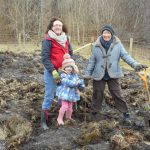- info@sirhowyhillwoodlands.co.uk
- Thomas Ellis Way, Tredegar NP22 4QF
- About Us
- Get involved
- Visit Us
Visit Tredegar & our Woodlands
Come and visit us!
Sirhowy Hill Woodland
Thomas Ellis Way
Tredegar
Blaenau Gwent
NP22 4QF - Wildlife
- Woodland Shop
Latest and greatest products, direct from our
Woodland Shop
Sourced from the Woodlands and the local community.
You have
item(s) in your bag
- Home
- /
- Blog
- /
- Animals & Wildlife
- /
- Mammals
- /
- Rabbit

Scientific name: Orytolagus cuniculus
Rabbit
Originally from Spain and south-west France, the rabbit was brought to England in the 12th century AD by the Normans and kept in captivity in warrens as a source of meat and fur. Many escaped into the wild and eventually become so common that farming them was no longer economic. Helped by fast breeding, a diet of virtually any vegetable matter and persecution of predators, the rabbit slowly established itself in the wild in Britain, despite originally favouring a warmer, drier climate.
In the 1950s, the disease myxomatosis was introduced to curb their numbers and the rabbit almost became extinct, but is once again a common animal of the countryside. It can be a serious pest for farmers, eating and damaging crops.
The male is called a buck and the female a doe. The main predators of rabbits are the stoat and the fox, although young animals also fall to birds of prey and weasels.
What do Rabbits eat?
Leaves and shoots of a range of vegetation, including crops. In winter, grass, bulbs and bark. As their diet is hard to digest, rabbits eat their food twice. After eating they produce soft droppings that still have high nutritional value. They eat these, and then produce hard pellets of waste material.
When will I see a Rabbit?
At any time if the year, more often at night.
What does a Rabbit eat?
Grasses including Common Couch (Elytrigia repens) and Cock’s-foot (Dactylis glomeratus).
Where will I see a Rabbit?
Throughout the garden, especially the lawn. Also in parks, heaths, grassland, meadows, woodland and sometimes sand dunes.

Click to view more
Statistics
Scientific Name
Orytolagus cuniculus
Location
England, Wales, Scotland and Ireland
Size
Length: 40 - 45 cm
Length of Ears: 8.5 cm
Weight: 1.1 to 2.5kg
Population
Pre-breeding season estimated to be 40 million.
Habitat
Abundant in grassland areas where the soil allows them to make extensive, well-drained burrows, but also where there are hedges or patches of woodland to give shelter and cover.

Other Wildlife







